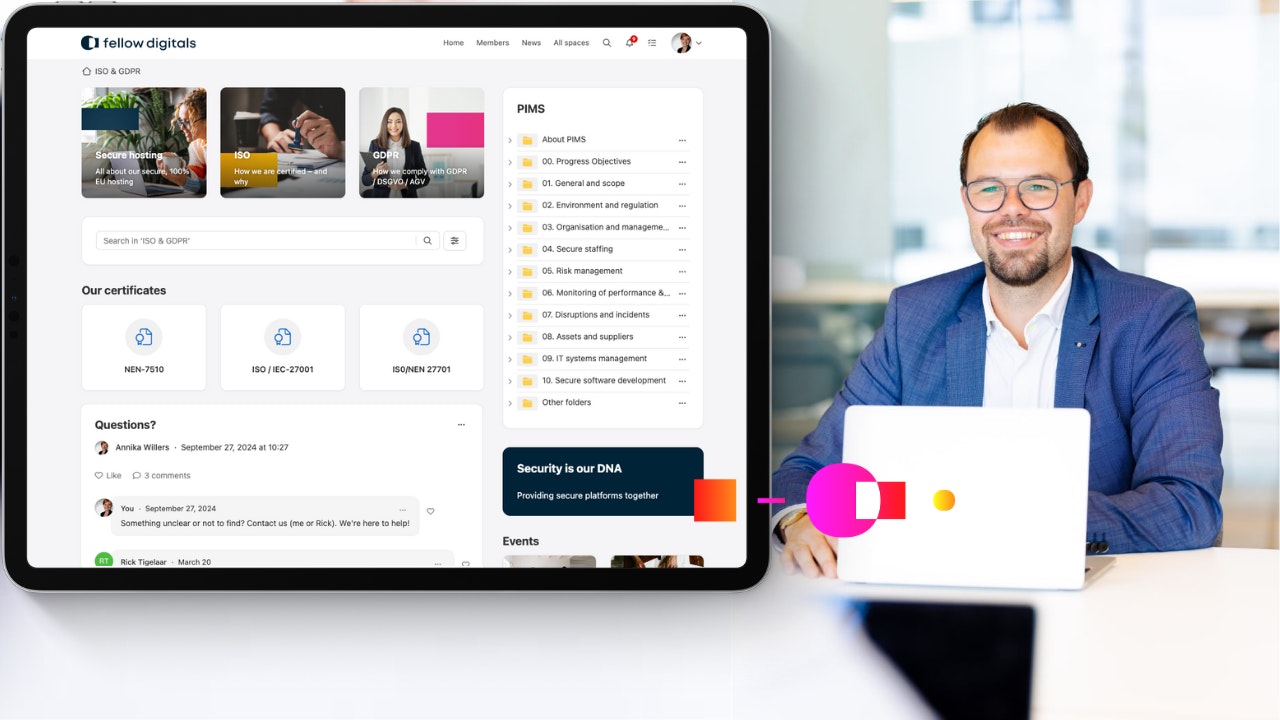Europe wake up: Trump is having your (AI) data for breakfast
Blog | Opinion

I’m not one to spread panic, but I do know this: everything you put into an American cloud today could be sitting on a desk in Washington tomorrow. It’s not about the flashy AI technology behind that software—it’s about the everyday data your organisation is feeding into it. The good news? There’s a way out.
That escape route starts with Sarah. She’s an HR manager at a Dutch government agency. Like so many others, her organisation has long relied on familiar platforms like Microsoft and Google—products powered by American clouds. Sarah’s learning management system (LMS) dashboard neatly tracks the progress, scores, and learning achievements of over 1,700 employees. So far, so good.
What Sarah doesn’t see: all that personal data—from skills to test results—legally falls under the Stars and Stripes. Her LMS is American-made. Without knowing it, she’s handing over her digital crown jewels daily. And she’s not alone: governments, schools, and healthcare institutions are running en masse on American infrastructure—bringing with it a range of risks.
Sarah represents all European managers using AI or SaaS tools hosted in American clouds. Her story highlights how vulnerable our data truly is—and how Trump 2.0 turns that risk up to eleven. But there are European alternatives for organisations that want to stay in control.
Trump 2.0 – Why the risks are now exploding
As of January 2025, Donald Trump is once again in the White House and has accelerated his America First agenda. Within six weeks, he imposed 25% import tariffs on European steel and aluminium and slapped a 10% tariff on nearly all EU goods. A month later, he declared that “the EU is in many ways worse than China,” threatening more hikes unless Brussels gives in. Not long after, he backtracked—somewhat. Trust in the US as a reliable partner is plummeting.
That volatility directly affects your data. When trade tensions escalate, Washington still holds one powerful bargaining chip: extraterritorial data legislation. The CLOUD Act and FISA §702 already grant the US government access to any byte stored in an American cloud. Under a president who uses trade as a weapon, the leap to leveraging that access strategically—say, to gain the upper hand in negotiations—is frighteningly small.
“If her LMS or HRM tool runs on an American cloud, her employee database is not only legally vulnerable but also a potential bargaining chip in Trump's trade war.”
AI and data: innovation with a price tag
In the geopolitical reality show of 2025, data sovereignty isn’t a luxury—it’s a necessity. McKinsey reports that 78% of companies worldwide already use AI applications. Great for productivity, but there’s a hidden cost: your HR data becomes training fodder for algorithms you have zero control over. As Apple CEO Tim Cook once put it: “If you’re not paying for the product, you are the product.”
For Sarah, this hits home. Her LMS doesn't just contain videos and multiple-choice questions; it logs test results, learning behaviour, certifications, and sometimes psychometric tests. Feed that data into a generative AI tool from a US provider, and they can use it to refine their models—even for your competitors.
Her learning data isn’t just course material—it’s also fuel for someone else’s AI.
American laws: The invisible hand in your european data
Two laws govern your cloud without mercy: the CLOUD Act and FISA §702. Both compel American providers to surrender data—even if the server is physically in Berlin, London, or Amsterdam. In April 2024, the Senate extended §702 through 2026 and broadened its scope: now any US company can be forced to assist with surveillance requests.
Privacy activist Max Schrems helped invalidate the EU-US Privacy Shield, which once promised that EU citizens' data sent to the US would meet European privacy standards (GDPR). It’s been replaced by the Data Privacy Framework, intended to align better with GDPR requirements. Schrems summed it up: “EU law demands privacy, US law demands surveillance—those are fundamentally incompatible.
“One subpoena is all it takes for her LMS data to land in Washington—even if the server’s in Amsterdam.”
The grim numbers
100% – US law (CLOUD Act & FISA §702) gives authorities access to any byte running through a US platform.
60% – Organisations without a clear generative AI policy, or unaware if one exists (KPMG, 2024).
3–5 years – Europe’s lag in secure AI infrastructure (Competitiveness Compass 2025).
European legislation: The AI Act as opportunity and challenge
The EU AI Act was adopted in 2024 and begins enforcement in phases from August 2025. It classifies AI systems into four risk levels: unacceptable, high, limited, and minimal. HR tools like recruitment systems and LMSs often fall into the high-risk category—especially those involved in assessments or promotions.

This means:
Documentation requirements – Clearly state what model/platform you use and what data is involved.
Transparency – Employees must know when they’re interacting with AI.
Fines – Up to €30 million or 6% of global turnover for non-compliance.
Sound intense? It is. Especially since enforcement won’t kick in until 2027. Until then, you’re on your own.
But I see opportunities.
Sarah must raise the alarm internally and make it clear that a European, GDPR-compliant LMS is essential. It builds trust with privacy officers and prevents panic-driven migrations later. As Ursula von der Leyen often says: “In Europe, people come first—not market share.” And for an HR manager, those people are your employees.
If she switches now to a European LMS, she won’t have to migrate in a rush later.
All in Europe: Yes, it can be done
Absolute security doesn’t exist—but if you want to reduce risk, host your data in Europe. Key criteria for any SaaS system:
Hosted in the EU
ISO 27001 & NEN 7510 certified
No exposure to CLOUD Act / FISA §702
Logs erased automatically after processing.
LMS Providers and data risk comparison
Starting point: three simple checkpoints — where is the data located? Are we subject to the CLOUD Act/FISA? Are the terms clear? The table below shows at a glance that a green checkmark for server location means little when the provider is American.

The same pattern applies across US-based SaaS tools—from applicant tracking systems to project management software. The law follows the company, not the server.
Popular HR platforms at a glance
Many organisations—including Sarah’s—rely on integrated HR suites. The following table lists the parent company and country of origin of several widely used systems, giving you a clear view of whether your HR data may fall under U.S. jurisdiction.

*SAP is German, but its SuccessFactors cloud runs partly on US-based data centres. Always check physical hosting and subcontractor access.
Toward digital sovereignty: Why this affects us all
Tech is geopolitics. If Sarah’s HR data ends up on Trump’s desk, her employees become pawns in a power play. Former EU Commissioner Margrethe Vestager put it plainly: “Whoever controls data, controls the future.” That future isn’t abstract—it’s your team lead’s performance review or a warehouse worker’s failed safety module test.
Digital autonomy impacts retention, employer branding, and your license to collect data
Conclusion
We stand at a crossroads. Continue blindly on American AI infrastructure—or choose European autonomy? For Sarah, the answer is clear: start today with a proof of concept for an EU-hosted LMS. Make data sovereignty a central criterion in every SaaS contract. What applies to your LMS also applies to your CRM, ATS, and ERP.
My advice to Sarah: review your contracts, question your vendors, and make sure the privacy section doesn’t become a legal headache.
And for Sarah—as well as her peers in municipalities, provinces, and other public bodies—an extra responsibility applies. Data sovereignty is not a ‘nice to have,’ but a moral obligation. Public organisations must lead by example. Serving the public interest means demanding public control over data.
Fellow Digitals – Doing it right
At Fellow Digitals, we believe in true digital sovereignty. Our platforms are built and hosted entirely in Europe, fully GDPR-compliant, and never subject to extraterritorial US laws like the CLOUD Act or FISA §702. Whether you’re in government, healthcare, or education—we give you back full control over your data.
👉 Learn more and discover how we keep your data safe, secure, and sovereign.
We love to share our knowledge with you
Related blogs



